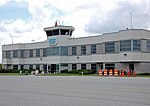Charlotte Motor Speedway

Charlotte Motor Speedway is a motorsport complex located in Concord, North Carolina, 13-mile (21 km) outside Charlotte. The complex features a 1.500 mi (2.414 km) quad oval track that hosts NASCAR racing including the prestigious Coca-Cola 600 on Memorial Day weekend, and the Bank of America Roval 400. The speedway was built in 1959 by Bruton Smith and is considered the home track for NASCAR with many race teams located in the area. The track is owned and operated by Speedway Motorsports with Greg Walter as track president. The 2,000 acres (8.1 km2) complex also features a state-of-the-art 0.250 mi (0.402 km) drag racing strip, ZMAX Dragway. It is the only all-concrete, four-lane drag strip in the United States and hosts NHRA events. Alongside the drag strip is a state-of-the-art clay oval that hosts dirt racing including the World of Outlaws finals among other popular racing events.
Excerpt from the Wikipedia article Charlotte Motor Speedway (License: CC BY-SA 3.0, Authors, Images).Charlotte Motor Speedway
Morehead Road, Concord
Geographical coordinates (GPS) Address Nearby Places Show on map
Geographical coordinates (GPS)
| Latitude | Longitude |
|---|---|
| N 35.3525 ° | E -80.6825 ° |
Address
Charlotte Motor Speedway
Morehead Road
28075 Concord
North Carolina, United States
Open on Google Maps



